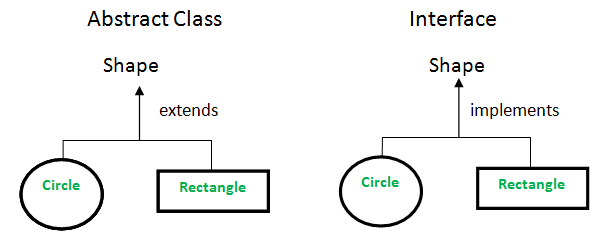Prerequisite
Interface
An interface is an abstract "class" that is used to group related methods with "empty" bodies: To access the interface methods, the interface must be "implemented" (kinda like inherited) by another class with the implements keyword (instead of extends ).
Abstract Class
Abstract class is a restricted class that cannot be used to create objects (to access it, it must be inherited from another class).
Abstraction: Hiding the internal implementation of the feature and only showing the functionality to the users. i.e. what it works (showing), how it works (hiding). Both abstract class and interface are used for abstraction.
Abstract class vs Interface
1. Type of methods: Interface can have only abstract methods. Abstract class can have abstract and non-abstract methods. From Java 8, it can have default and static methods also.
2. Final Variables: Variables declared in a Java interface are by default final. An abstract class may contain non-final variables.
3. Type of variables: Abstract class can have final, non-final, static and non-static variables. Interface has only static and final variables.
4. Implementation: Abstract class can provide the implementation of interface. Interface can’t provide the implementation of abstract class.
5. Inheritance vs Abstraction: A Java interface can be implemented using keyword “implements” and abstract class can be extended using keyword “extends”.
6. Multiple implementation: An interface can extend another Java interface only, an abstract class can extend another Java class and implement multiple Java interfaces.
7. Accessibility of Data Members: Members of a Java interface are public by default. A Java abstract class can have class members like private, protected, etc.

// Java program to illustrate the
// concept of abstract class
import java.io.*;
// abstract class
abstract class Shape
{
// declare fields
String objectName = " ";
Shape(String name)
{
this.objectName = name;
}
// declare non-abstract methods
// it has default implementation
public void moveTo(int x, int y)
{
System.out.println(this.objectName + " " + "has been moved to"
+ " x = " + x + " and y = " + y);
}
// abstract methods which will be
// implemented by its subclass(es)
abstract public double area();
abstract public void draw();
}
class Rectangle extends Shape
{
int length, width;
// constructor
Rectangle(int length, int width, String name)
{
super(name);
this.length = length;
this.width = width;
}
@Override
public void draw()
{
System.out.println("Rectangle has been drawn ");
}
@Override
public double area()
{
return (double)(length*width);
}
}
class Circle extends Shape
{
double pi = 3.14;
int radius;
//constructor
Circle(int radius, String name)
{
super(name);
this.radius = radius;
}
@Override
public void draw()
{
System.out.println("Circle has been drawn ");
}
@Override
public double area()
{
return (double)((pi*radius*radius)/2);
}
}
class GFG
{
public static void main (String[] args)
{
// creating the Object of Rectangle class
// and using shape class reference.
Shape rect = new Rectangle(2,3, "Rectangle");
System.out.println("Area of rectangle: " + rect.area());
rect.moveTo(1,2);
System.out.println(" ");
// creating the Objects of circle class
Shape circle = new Circle(2, "Cicle");
System.out.println("Area of circle: " + circle.area());
circle.moveTo(2,4);
}
}
Output:
Area of rectangle: 6.0
Rectangle has been moved to x = 1 and y = 2
Area of circle: 6.28
Cicle has been moved to x = 2 and y = 4
In you don’t have any common code between rectangle and circle then go with interface.
// Java program to illustrate the
// concept of interface
import java.io.*;
interface Shape
{
// abstract method
void draw();
double area();
}
class Rectangle implements Shape
{
int length, width;
// constructor
Rectangle(int length, int width)
{
this.length = length;
this.width = width;
}
@Override
public void draw()
{
System.out.println("Rectangle has been drawn ");
}
@Override
public double area()
{
return (double)(length*width);
}
}
class Circle implements Shape
{
double pi = 3.14;
int radius;
//constructor
Circle(int radius)
{
this.radius = radius;
}
@Override
public void draw()
{
System.out.println("Circle has been drawn ");
}
@Override
public double area()
{
return (double)((pi*radius*radius)/2);
}
}
class GFG
{
public static void main (String[] args)
{
// creating the Object of Rectangle class
// and using shape interface reference.
Shape rect = new Rectangle(2,3);
System.out.println("Area of rectangle: " + rect.area());
// creating the Objects of circle class
Shape circle = new Circle(2);
System.out.println("Area of circle: " + circle.area());
}
}
output
Area of rectangle: 6.0
Area of circle: 6.28
When to use what?
Consider using abstract classes if any of these statements apply to your situation:
- In java application, there are some related classes that need to share some lines of code then you can put these lines of code within abstract class and this abstract class should be extended by all these related classes.
- You can define non-static or non-final field(s) in abstract class, so that via a method you can access and modify the state of Object to which they belong.
- You can expect that the classes that extend an abstract class have many common methods or fields, or require access modifiers other than public (such as protected and private).
Consider using interfaces if any of these statements apply to your situation:
- It is total abstraction, All methods declared within an interface must be implemented by the class(es) that implements this interface.
- A class can implement more than one interface. It is called multiple inheritance.
- You want to specify the behavior of a particular data type, but not concerned about who implements its behavior.





0 comments:
Post a Comment